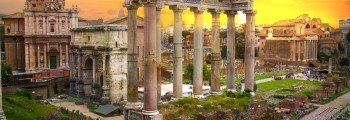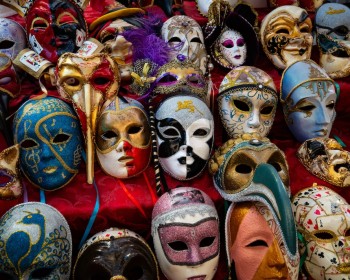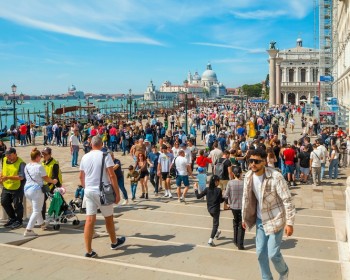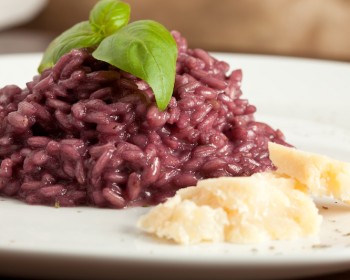Generally known for the Carnival and for the beautiful masquerade parties, Venice is one of the best cities to visit because whether you have the time or just half day, whether you are young or adult, whether you need some relax or you just want to have some fun, Venice can suits your wishes and needs.
Venice is divided into six districts, each of them is called sestiere: Cannaregio, Dorsoduro, San Polo, San Marco, Santa Croce, Castello. I am about to give you just a hint of what to see in each of these sestieres, so you can plan the perfect itinerary to discover these amazing neighbourhoods.
Cannaregio
In Cannaregio you can touch the real Venetian life. This name comes from the original territory on which now Cannaregio is built, that is to say a swampland full of rushes.
In XIXth century Santa Lucia station was built in Cannareggio, this was the first time in which Venice was connected to the land through a railway bridge going from Mestre exactly to Venice.
From this station to Rialto you have just to go straight on the main street known as Strada Nova.
It is the second most populated sestiere and you have the chance to discover a different Venice, a Venice that is not recounted in the classical tour. Walking through the alleys you will be immersed in coloured houses, gondoliers with their traditionally striped shirts, artists and artisans that try to capture the real essence of this district in their works.
Proceeding on the streets of Cannaregio, precisely after the “Ponte delle Guglie” you will reach the Jewish Ghetto, the oldest Italian ghetto built in 1516 where you can still see synagogues and the gate used to close the ghetto in the night because in the past its inhabitants were allowed to go out only during the day with some distinguishing features.
Castello
The name of this area derives from the old fort around which the sestiere expands now. This is the biggest sestiere of the city and comparing the shape of Venice to a fish, Castello could be the tail of this one. This sestiere is the only one that doesn’t look out onto the Canal Grande. Probably in the past, Castello had some military power because of the presence of the old fort that probably now is the so-called Arsenale, which had been closed by Napoleon.
Dorsoduro
Probably this name was created to indicate an area in which the ground wasn't so swamped as the other parts of the old territory. It includes also the Giudecca Isle, considered part of the administration of this district.
In Dorsoduro there are a lot of museums. The most important is the “Gallerie dell’Accademia” where you can appreciate a lot of work from the Venetian production of the period between centuries XIV and XVIII, painters like Tintoretto, Tiziano and some of Leonardo Da Vinci’s sketches.
Furthermore, there’s the Peggy Guggenheim Collection, a modern art museum on the Grand Canal.
It is one of the most visited attractions in Venice. The collection is housed in the “Palazzo Venier dei Leoni” an 18th-century palace, once Peggy Guggenheim’s home.
This museum gathers a small collection by comparison with other Guggenheim museums, but here you can find works from Mirò, Magritte, Kandinsky, Picasso and Dalí that make it one of the most-visited site in Venice.
Beyond the Grand Canal, you can see San Marco’s Basilica, but you can only reach it through the Ponte dell’Accademia. This is the most vital neighbourhood of Venice, in fact, there is a famous place called Campo Santa Margherita, with reference to the deconsecrated church of the same name, that is known more for the nightlife rather than for the mentioned church. Here a lot of young people meet when they go out because of both the wide variety of pubs and bars all around the square and the presence of universities and stations (train station and bus station) in the area.
Santa Croce
The name comes from Santa Croce’s church, demolished with Napoleon’s suppressions.
This place has been suffering many changes in the Twentieth century because of the connection between Venice and the mainland, first of all, due to the maritime station, then to the bus station, in the end to the Tronchetto artificial island-parking lot.
San Marco
Of course, is the sestiere in which you can find San Marco’s Basilica. The core of this sestiere is San Marco Square, the political and judiciary center for over a thousand years.
In San Marco’s Basilica, also known as the Golden Church, you can see the gold mosaics on all ceilings and upper walls, the fourteenth century, all contributed to its adornment, with many elements being brought from ancient Byzantine buildings, such as mosaics, columns, capitals and friezes. From the religious area, your tour can proceed with the visit of the political centre of the town, the Doge's Palace. The city was ruled by Doges and you are going to visit their Palace, the rooms and the hall of the council and the guide will tell you about the architecture at that time and how the life was for the Doges in Venice.
Beyond you can visit the Bridge of Sighs where you can discover the secrets of this mysterious place. The name is due to the fact that it is traditionally believed that prisoners who were going to be judged, had a sigh because they were looking at the external world for the last time while crossing the bridge.
San Polo
The name of this sestiere derives from both Campo San Polo, the biggest campo of Venice, and San Polo’s Church, and it’s exactly the center of the city map.
The most important part of this district is obviously the Rialto area, with Rialto Bridge, and San Giacomo di Rialto’s Church, considered the oldest church of Venice (around VI century). In 1594 Rialto Bridge took the place of a very old wooden bridge made with boats, which linked the city to the crowded Rialto Market. Today the bridge is full of tourists and sellers and is one of the most photographed spots in the world.
This sestiere has the widest variety of bacari, typical Venetian osterie in which you can taste Venetian cicchetti, small snacks or side dishes, tiny sandwiches, plates of olives or other vegetables, halved hard boiled eggs, small servings of a combination of one or more of seafood, meat and vegetable ingredients laid on top of a slice of bread or polenta.
A particular phenomenon of Venice is the so-called “acqua alta” above all during the period between October and March. Due to a peculiar combination between tide, wind and atmospheric pressure the high tide can flood a great part of the city making movements very difficult. In Venice there is a lot of humidity, it’s very cold in winter and very much crowded and hot in summer. So, if you want to have the best journey to Venice try to visit it in spring when there are fewer people and you can explore the city in an enjoyable way. There is a lot of fun in this fantastic and bizarre city for your kids too.
For sure there’s a reason if Shakespeare chose this city for setting his “Merchant of Venice” and “Othello”. And a lot of movies were located there, like Indiana Jones, James Bond and Lara Croft: Tomb Raider.
In “Summertime” an old movie from 1955, someone tells Katherine Hepburn that Venice has a different effect on people, somebody finds it too quiet, somebody else on the contrary thinks it’s too noisy, but in most cases people find it beautiful. And even if she has never been there she answers: “Well, I guess I’ll settle with the majority”.
You should totally go there!











